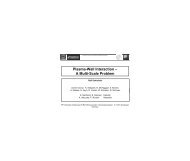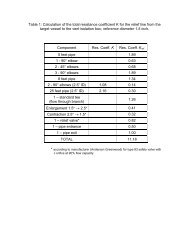The Nu-SNS proposal - ORNL Physics Division - Oak Ridge ...
The Nu-SNS proposal - ORNL Physics Division - Oak Ridge ...
The Nu-SNS proposal - ORNL Physics Division - Oak Ridge ...
You also want an ePaper? Increase the reach of your titles
YUMPU automatically turns print PDFs into web optimized ePapers that Google loves.
Figure 2.2 <strong>SNS</strong> neutrino production mechanism.<br />
<strong>The</strong> time structure of the <strong>SNS</strong> beam is particularly advantageous for neutrino studies. Time<br />
correlations between candidate events and the <strong>SNS</strong> proton beam pulse will greatly reduce<br />
background rates and may provide sensitivity to neutral current events. As shown in the left<br />
panel of Figure 2.3, all neutrinos will arrive at the ν-<strong>SNS</strong> location within several microseconds<br />
of the 60 Hz proton beam pulses. As a result, background events resulting from cosmic rays will<br />
be suppressed by a factor of ~2000 by ignoring events which occur too long after a beam pulse.<br />
At the beginning of the beam spill the neutrino flux is dominated by muon neutrinos resulting<br />
from pion decay, perhaps making it possible to isolate pure neutral-current events. This exciting<br />
possibility is quite challenging due to the presence of a large number of high energy neutrons,<br />
the most important source of beam-induced background from the <strong>SNS</strong>. Investigations of the<br />
achievable time resolution and consultations with <strong>SNS</strong> operations staff about minimizing beam<br />
losses (both necessary to meet this challenge) will be a part of our proposed R&D effort in the<br />
next two years. However, charged-current measurements can be made essentially backgroundfree<br />
because the neutron backgrounds are greatly suppressed for t > ~1 µs after the start of the<br />
beam spill while the neutrino production, governed by the muon lifetime<br />
(τ µ ~ 2.2 µs), proceeds for several microseconds. This time structure presents a great advantage<br />
over a continuous-beam facility such as the Los Alamos Neutron Science Center (LANSCE),<br />
where the LSND experiment was located.<br />
<strong>The</strong> energy spectra of <strong>SNS</strong> neutrinos are shown in the right hand panel of Figure 2.3. <strong>The</strong>se<br />
spectra are known because almost all neutrinos come from decay-at-rest processes in which the<br />
kinematics are well defined. <strong>The</strong> decay of stopped pions produces monoenergetic muon<br />
neutrinos at 30 MeV. <strong>The</strong> subsequent 3-body muon decay produces a spectrum of electron<br />
neutrinos and muon antineutrinos with energies up to 52.6 MeV. This energy range overlaps<br />
extremely well with the range of neutrino energies in supernovae (see Figure 2.4). Cross sections<br />
for neutrino interactions at these energies are crucial for understanding supernova dynamics,<br />
nucleosynthesis, and the response of terrestrial supernova neutrino detectors, as discussed in the<br />
previous section.<br />
ν-<strong>SNS</strong> Proposal 8 8/4/2005



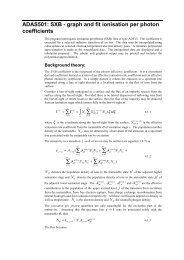
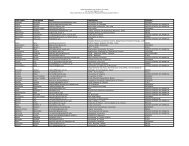
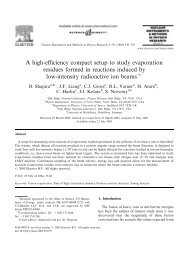
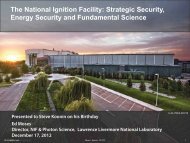

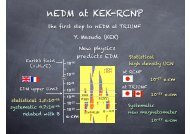
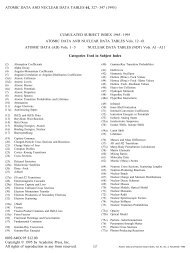


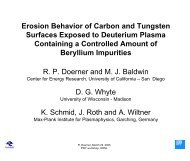
![Mixed-mode Calculations within the Nuclear Shell Model [pdf]](https://img.yumpu.com/28265410/1/190x146/mixed-mode-calculations-within-the-nuclear-shell-model-pdf.jpg?quality=85)
